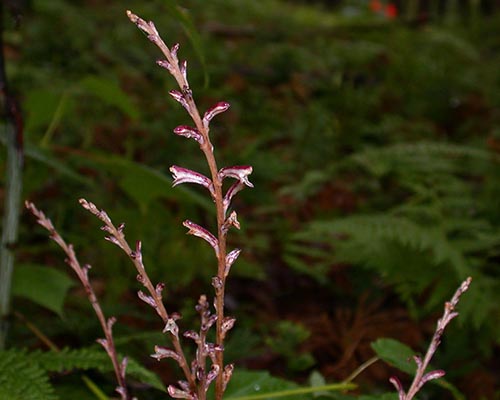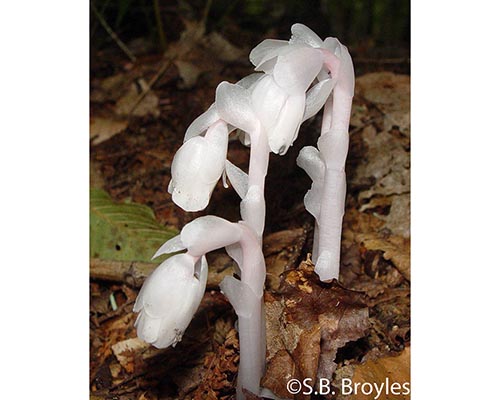Most plants are autotrophs because they make their own food by photosynthesis. But for every rule there is an exception. Some plants are non-photosynthetic and parasitic, obtaining their food through a host. All parasitic plants have special organs called haustoria that infiltrate into the host plant’s tissues and extract water and nutrients. Parasitic plants can be holoparasites, with virtually no chlorophyll and thus completely parasitic, or they can be hemiparasites, with the ability to photosynthesize to some degree. We will focus on holoparasites here.
Beechdrops (Epifagus americana) is a holoparasitic plant that lives off of beech trees. Indeed, the genus name Epifagus literally means “upon beech.” Beechdrops has neither leaves nor chlorophyll; instead, its haustoria connect to the roots of the beech below ground. In fact, what you see above ground is just the flowering part of the plant. Between August and October, it produces small, purplish flowers. Actually, it produces two different types of flowers: flowers that self-pollinate (called cleistogamous flowers) and flowers that cross-pollinate with other plants (called chasmogamous flowers). To avoid exhausting its only food supply, it becomes dormant in the winter with its host beech tree (see the Plant Evolution IV: Angiosperms).
Indian pipe, ghost plant, or corpse plant (Monotropa uniflora) is a holoparasitic plant with an even more remarkable ecology. Its hosts are mycorrhizal fungi, which are themselves mutualists that derive their energy from a host tree (see the Fungi station for more about mycorrhizae, and the Symbiosis station for more about mutualism versus parasitism). So the Indian pipe is ultimately feeding off of a host tree, but it does so through an intermediary. It is not clear whether the mycorrhizal intermediary is harmed by this relationship or possibly even benefits in some way.
Indian Pipe has no chlorophyll. In fact, it has virtually no pigments at all, and is thus a waxy, corpulent white, although rare variants are a deep red color, perhaps a genetic vestige of its ancestral coloration. It does have tiny, scale-like leaves, generally also without pigmentation. It grows only 2–12 inches tall, with one drooping, bell-shaped flower per stem. During flowering season, from June to September, it is insect-pollinated. Following its bloom, the flower will point straight up and the stem will darken, the condition you find the plant in for most of the growing season. Indian pipe prefers shaded sites with rich soils and is often found close to decaying matter, leafy mulch or tree roots. It is often found with beech or sometimes pines or oaks.


